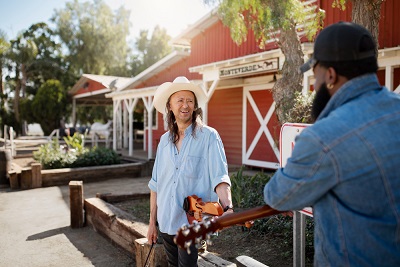Is that old tin shed out the back finally giving up the ghost? Are the kids’ bikes slowly taking over the garage, pushing the ute out into the blazing sun? Or maybe you’ve finally snagged that boat or caravan, and it needs a proper home away from the elements.
Whatever your reason, choosing a new shed is a true blue Aussie rite of passage. It’s not just about throwing up four walls and a roof; it’s about creating space for your passions, securing your gear, and adding a ripper asset to your property.
But let’s be honest, with so many options out there, it can feel as confusing as a kangaroo in a revolving door. Don’t you worry! We’ve put together this no-nonsense, fair dinkum guide to help you cut through the noise and choose the perfect shed for your needs, your block, and your budget.
First Things First: What’s the Shed For, Mate?
Before you even think about colours or designs, you need to have a proper yarn with yourself about what this shed will actually do. Its primary job will dictate everything else.
The Humble Garden Shed
The classic. Perfect for stowing the mower, garden tools, pots, and that bag of fertiliser you swear you’ll use one day.
The Mighty Workshop
This is a sanctuary for tinkering, building, and creating. It needs to be spacious, well-lit, and able to handle heavy-duty shelving and workbenches.
The All-Rounder Garage Shed
The workhorse of the backyard. It protects the car from hail, stores the outdoor toys, and houses the deep freezer. Often needs a wider door and a strong, clear span interior (no obstructive poles!).
The Massive Machinery Shed
For the big blocks and the serious gear. We’re talking tractors, harvesters, hay bales, or housing livestock. Size, strength, and clearance are everything here.
How to Choose: Your Step-by-Step Checklist
Righto, now that you know the why, let’s get into the how. Follow these steps to make sure you’re on the right track.
Step 1: Measure Your Space (Twice, Order Once!) Grab a tape measure and get out there. Measure the exact area where you want the shed to live. Now, add a metre or two around all sides for access, drainage, and future maintenance. Don’t forget to check for overhead obstacles like power lines or tree branches!
Step 2: Check the Lay of the Land Is the site flat and level? If not, you’ll need to factor in site preparation costs like levelling and a concrete slab. A good slab is the foundation of a shed that will last for decades. For more on this, check out our guide on preparing your site for a new shed.
Step 3: Understand Council Rules & Regulations This is a biggie. Most councils require development approval for sheds over a certain size (usually 10sqm, but it varies). There are rules about setbacks from boundaries, height restrictions, and even colour choices. A quick call to your local council can save you a massive headache later on. A reputable shed company will also have a good handle on this.
Step 4: Pick Your Materials & Design
- Frame: Galvanised steel is the go-to for strength and rust resistance.
- Cladding: Colourbond steel is the Aussie champion. It’s tough, comes in heaps of colours to match your home, and is fire-resistant.
- Roof Pitch: A steeper pitch (like 15° or more) is better for shedding water and heavy rain, and it gives you more internal height.
- Doors: Sliding doors save space, while roller doors are a modern, secure option. For a workshop, consider a double-width option.
Step 5: DIY or Get It Installed? Are you a handy legend with a team of willing (beer-paid) mates? A DIY shed kit might be for you. If you’d rather leave it to the pros and know it’s done perfectly, professional installation is worth every cent for the peace of mind. Companies specialising in high-quality Perth sheds often offer full turnkey solutions from design to construction.
Pro Tips from the Shed Legends
- Go Bigger: It’s an old saying, but it’s true: “No one ever wished they’d built a smaller shed.” Future-you will thank you for the extra space.
- Light it Up: Plan for windows, skylights, or whirlybirds for natural light and ventilation. And definitely wire it for power – you’ll need it.
- Think Security: Don’t make it easy for the opportunists. Invest in a good lock for the door and consider security mesh on windows.
Your Shed Questions, Answered (FAQs)
Q: Do I really need a concrete slab?
A: For any shed you plan to walk into or store heavy items in, absolutely. A slab provides a level, stable, and permanent foundation. For lighter-duty garden sheds, a paved or crusher dust base can sometimes suffice.
Q: How long does it take to get a shed?
A: From initial quote to completion, it can take anywhere from a few weeks for a standard kit to a couple of months for a fully customised, installed solution, depending on council approval and manufacturer timelines.
Q: Can my shed be customised?
A: You bet! Reputable companies don’t just sell boxes. You can customise the dimensions, door and window placement, colours, and add extra features like gutters, insulation, or mezzanine floors. Need inspiration? Have a squiz at our ideas for maximising your shed storage.
Q: Will it survive our brutal summer sun and winter storms?
A: A quality ColorBond shed, engineered and installed correctly, is built to handle the harsh Aussie climate. The materials are designed for high UV resistance and incredible wind ratings.
Ready to Find Your Perfect Shed?
Choosing your shed shouldn’t be a chore. It’s an exciting project that will add incredible value and functionality to your home. By thinking about what you need, doing your homework, and partnering with a trusted local expert, you’ll end up with a shed that’s not just a building, but a proper part of the family.

